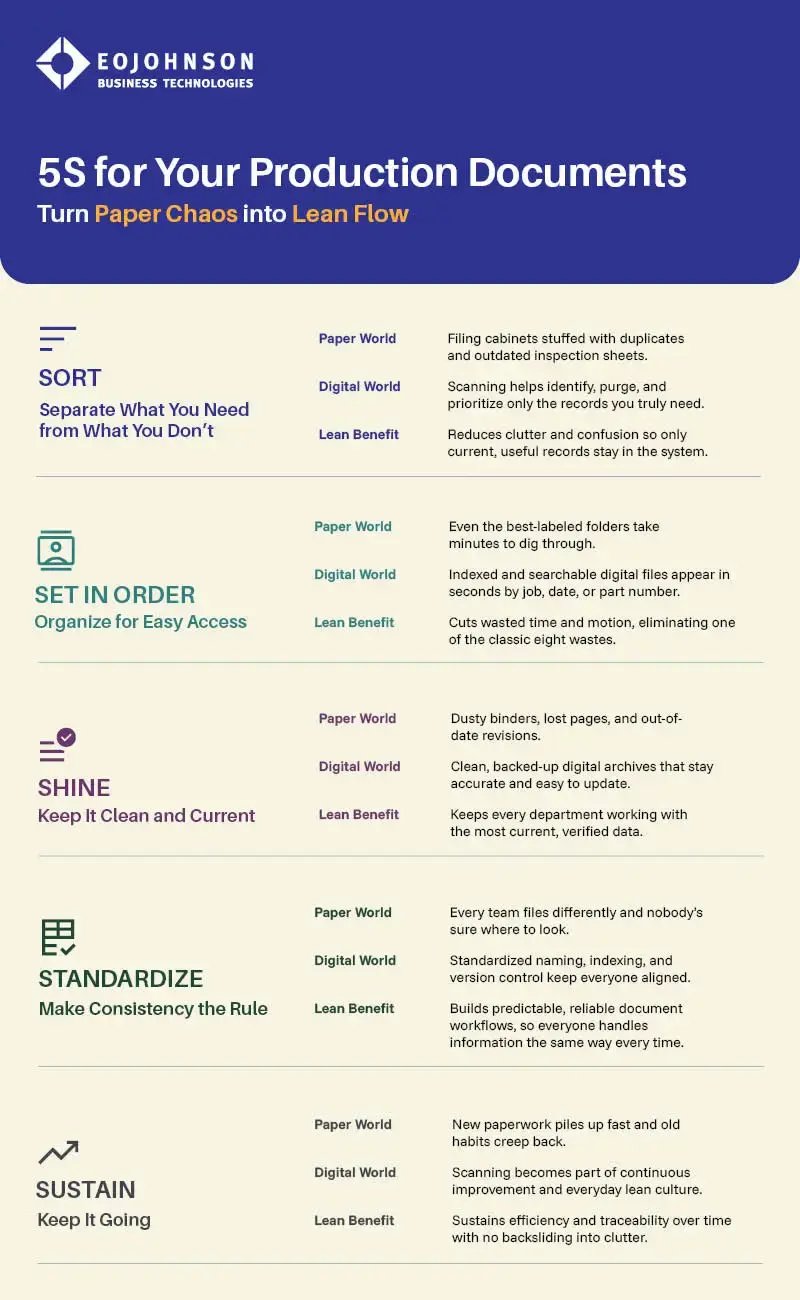Imagine a bustling production line running at full speed and robotic arms synchronized perfectly until someone needs a maintenance report from months ago. Suddenly, valuable time slips away as binders and folders are searched, revealing just how outdated paper-driven recordkeeping really is.
For manufacturers, stacks of paperwork and manual filing systems not only slow down operations but also increase the risk of lost or incomplete records, which can lead to failed audits or missed deadlines. Bulk document scanning offers a solution, transforming cluttered records into organized, searchable digital files that keep production moving smoothly.
What Is bulk document scanning for manufacturers?
Bulk document scanning means taking large volumes of paper records, like years’ worth of production logs, quality reports, or safety checklists, and turning them into digital files. Instead of just scanning a few pages at a time, it’s an organized, industrial-scale process designed for the real world of manufacturing.
Here’s how it works:
- Intake and sorting – All documents are collected and grouped by type, such as work orders, inspection forms, or maintenance records.
- High-speed scanning – Production-level scanners process thousands of pages per hour, creating clear digital copies.
- OCR and indexing – Optical Character Recognition (OCR) makes every word searchable, while indexing tags each file by date, job number, machine ID, or other necessary details.
- Quality control and storage – Files are checked for accuracy and uploaded into secure, easy-to-search digital storage.
Once digitized, these files can connect directly to your ERP or production systems to put accurate information at your fingertips.
How does bulk scanning improve production recordkeeping?
When your records are digital, you can find what you need in seconds. Maintenance reports, inspection forms, and production logs are all one quick search away. That means less time wasted digging through file cabinets and more time spent keeping production on track.
Lean manufacturing and 5S system support
The real power of bulk document scanning isn’t just speed. The power is in how it supports lean manufacturing principles, especially the 5S system of sort, set in order, shine, standardize, and sustain.
- Sort: Scanning forces you to decide what records actually matter. Old, duplicate, or irrelevant files get removed before digitizing, just like sorting tools or materials on the shop floor.
- Set in order: Digital indexing of production records brings instant order as every file is labeled and searchable by date, job number, or part ID. No more wasted motion or time.
- Shine: Clean, consistent digital archives mean everyone works from accurate, current data without dirty paperwork or outdated revisions.
- Standardize: Company-wide file naming and storage standards create reliable processes, the same way lean standard work does on the line.
- Sustain: Once scanning becomes routine, it reinforces a culture of continuous improvement where information flows as smoothly as materials do.

This connection between paperless production workflows and lean operations makes manufacturing document scanning more than convenient. It becomes a core part of operational data efficiency. Manufacturers who embrace this see real results like faster problem-solving, fewer errors, and audits that take hours instead of days.
Compliance and traceability advantages
Compliance is a constant in manufacturing, whether it’s ISO 9001, OSHA, or FDA documentation requirements. Bulk document scanning makes staying compliant easier and less stressful.
By scanning and indexing your records, every file becomes part of a searchable, auditable archive. During an inspection or audit, you can pull up exactly what’s needed in seconds without digging through boxes or binders.
Digitized files also improve regulatory documentation management. You can track version history, set access permissions, and ensure only authorized employees see sensitive data. With strong security and backup systems in place, scanned files are safer than paper.
In short, digital archives give you audit readiness and quality assurance compliance to help you stay organized, accurate, and confident in front of regulators and customers alike.
Financial and operational ROI impact
Scanning thousands of records might sound like a big investment, but the payback is quick and measurable.
When you switch to digital, you free up file storage areas for something that actually generates revenue. You cut the time it takes to retrieve a document from minutes to seconds. And you eliminate the risk of lost paperwork that can delay orders or cost you fines.
The result? Real cost reduction through digitization and long-term efficiency. Beyond the numbers, there’s also the benefit of better teamwork and faster decision-making. When everyone can access accurate information instantly, collaboration becomes easy.
How to select the right bulk document scanning vendor
Choosing the right partner for bulk document scanning is crucial to a successful digital transformation strategy. The vendor you select should offer more than just the necessary scanning equipment and should demonstrate security, reliability, and adaptability to your unique operational needs. Here are the key factors to consider:
- Security and chain of custody: Prioritize vendors that have robust security protocols in place. This includes secure data handling, encrypted transfers, and clear chain-of-custody documentation at every stage of the scanning process. Ask about their procedures for protecting sensitive or proprietary information and how they prevent unauthorized access.
- Budget flexibility and pricing terms: Seek out vendors who can tailor their pricing models to your project scope and budget constraints. Flexible budget options and transparent pricing that won’t change mid-project can help you manage costs.
- Experience and expertise: Choose a vendor with a proven track record. Industry experience means they understand your document types, compliance needs, and operational timelines. Ask for case studies or references that illustrate their ability to support a production-level scanning project.
- On-site needs assessment: The best partners offer on-site evaluations to understand your workflow, storage conditions, and specific scanning requirements. This hands-on approach ensures a customized solution that fits seamlessly into your process.
- Processing speed and capacity: Time is money in manufacturing. Assess the vendor’s turnaround times, scalability, and ability to handle high-volume projects without sacrificing quality. Fast, accurate processing minimizes downtime and accelerates your move to digital operations.
- Unique differentiators: Finally, consider what sets each vendor apart. This could include advanced indexing capabilities, integrated document management platforms, or specialized accreditations. These differentiators can deliver added efficiencies and long-term value to your digital transformation strategy.
By evaluating vendors against these criteria, manufacturing managers and operations leaders can make an informed decision and ensure a secure, efficient, and future-ready document scanning partnership.
Turning paper into performance
Paper records slow production, increase costs, and make compliance harder than it has to be. Document digitization for manufacturers changes that. It turns file rooms into digital dashboards and paperwork into performance data.
Bulk document scanning isn’t just a cost-saver. It’s the first real step toward digital transformation in manufacturing.
Ready to see what more streamlined recordkeeping? Partner with an experienced provider like EO Johnson and start turning your paper records into productivity gains today.






